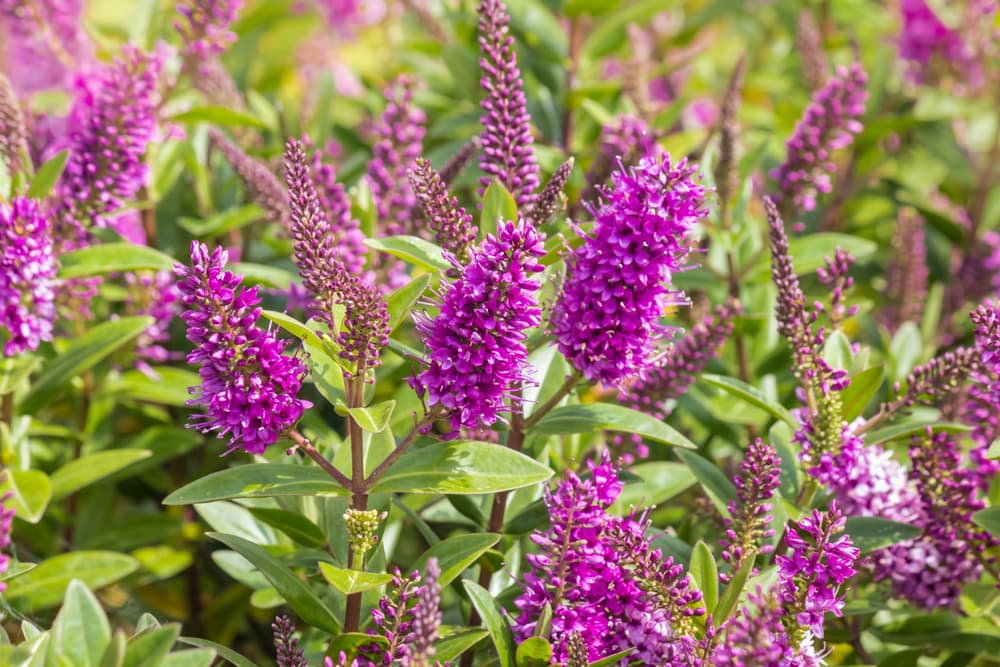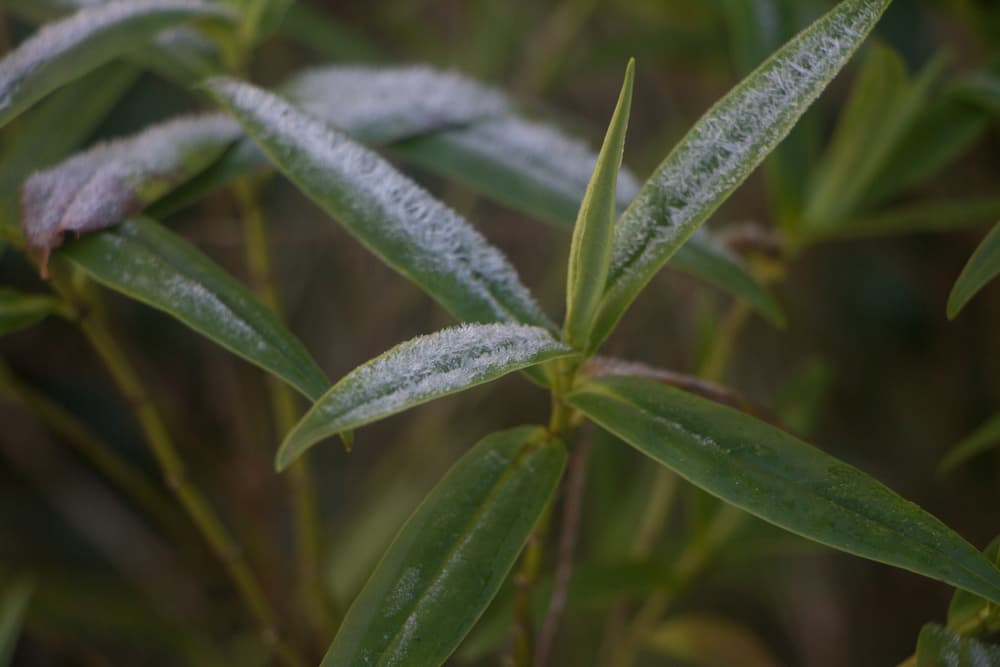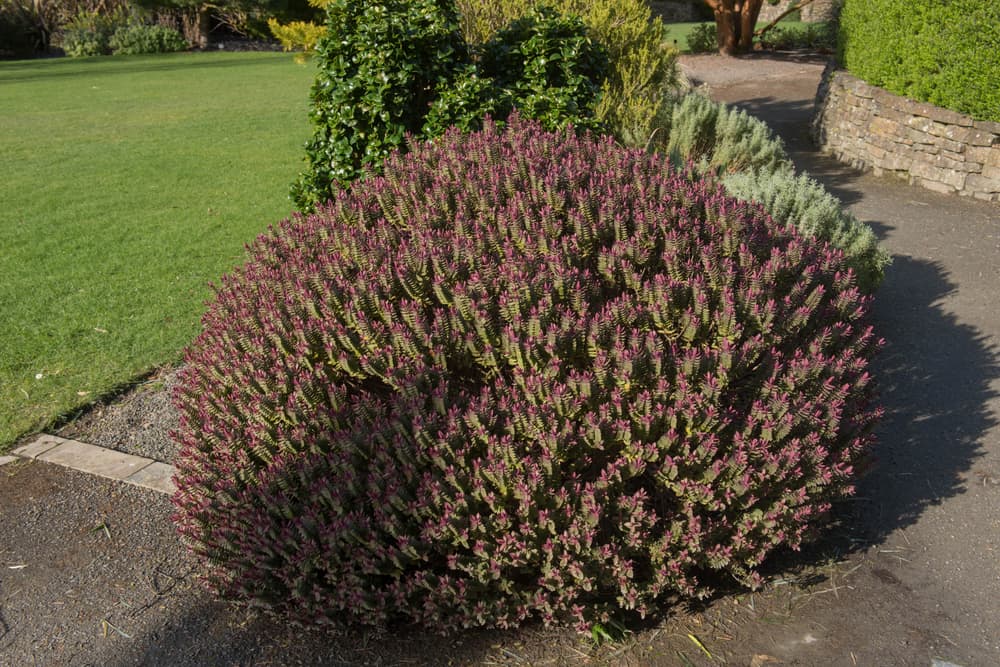SHRUBS > HEBE
Reviewed By COLIN SKELLY

Colin is a Horticulturist and Horticultural Consultant with experience in a range of practical and managerial roles across heritage, commercial and public horticulture. He holds the Royal Horticultural Society’s Master of Horticulture award and has a particular interest in horticultural ecology and naturalistic planting for habitat and climate resilience.
Contributions From CHARLIE BEWLEY

With over 35 years of experience growing hebes, Charlie Bewley is the Owner of Hic Bibi Wholesale Nurseries, based in Chorley, UK.
IN THIS GUIDE
Hebe is a plant known to be bushy and sprawling to upright and trim, with foliage ranging from greyish blue-green to a brilliant emerald hue.
With inflorescences in all kinds of shapes including spires, sprays, and ‘puffballs’, and in colours ranging from pastel pink to deep purple, this shrub spoils you for choice.
These immensely likeable plants are low-care evergreens; they are easy as 1-2-3: Plant, Gaze, and be Delighted!
We reached out to Charlie Bewley from Hic Bibi Wholesale Nurseries to contribute to this guide.
Pressed on his love for these plants, Charlie answers: “Hebes are evergreen, have a good range of foliage and flower colour and bees love their flowers – we get plenty of bees and other insects visiting our crops.”
Overview
| Botanical Name | Hebe |
| Plant Type | Shrub / Hedging |
| Native Area | New Zealand, Rapa, Falklands, South America |
| Hardiness Rating | H3/H4 |
| Foliage | Evergreen |
| Flowers | Racemes or spikes of small flowers |
| When To Sow | April, May, June, July, August, September |
| Flowering Months | July, August, September |
| When To Prune | April, May |
Sunlight
Preferred
Full Sun or Partial Shade
Exposure
Sheltered
Size
Height
0.5 – 2.5M
Spread
0.5 – 2.5M
Bloom Time
July – September
Soil
Preferred
Most Soil Types
Moisture
Moist but well drained
pH
Alkaline / Neutral
Hebe is a genus of evergreens that is native to New Zealand.
They are evergreens and are technically shrubs, most of which are of a bushy habit though there is variation in size; two or three species can reach even 2-2.5m in height.
Some species have a mat-forming habit and a few have an erect habit.
Though Hebe varieties’ leaves are simple and paired, quite a number of varieties are interesting for – besides other properties – the foliage, as their leaves display unusual textures, hues of green, or eye-catching variegation.

As for the flowers, their delightful inflorescences come in a diversity of shapes – tubular, sprays, spires, rays, salvers, ‘puffballs’ – and a range of colours across the blue-red spectrum, from the palest pastel to the deepest tone.
Adding to their charms, they flower all through summer and autumn with some varieties producing blooms in winter as well!
These wonderful plants are not only diverse and delightful, but they are also easy-care, trouble-free, tough, and well-suited to the British Isles as evidenced by the fact that RHS has accorded its Award of Garden Merit to thirty Hebe varieties.1See RHS Award of Garden Merit (AGM) plant, fruit & veg award winners. (n.d.). Royal Horticultural Society. Retrieved March 16, 2023, from https://www.rhs.org.uk/plants/trials-awards/award-of-garden-merit
Charlie cites Hebe pinguifolia ‘Pagei’ as one of his favourite varieties because of its unique foliage shape and subtle colour.
“Hebe ‘Pagei’ has delicate little globular foliage in a silvery colour. It is a spreading variety, so it is great for ground cover.”

If you’re a gardener who takes pleasure and joy from Nature’s boon of flowering plants in all their diverse beauty, then Hebe is one of your top picks.
Habitat & Growing Conditions
All but a few species of Hebe are native to New Zealand.2Hebe. (n.d.). Oregon State University. Retrieved March 16, 2023, from https://landscapeplants.oregonstate.edu/hebe
Though they grow throughout the island country, one cluster of species is partial to riparian zones and another grouping is concentrated in the country’s sub-alpine locations.
Sunlight & Aspect
In the wild these plants are found in open, unsheltered areas where they get full sun and also ‘full wind’, so to speak.

Therefore, these fuss-free plants are happiest in full sun but also do well in partial shade.
As a bonus, aspect has no bearing on these plants.
They are more tolerant of stiff winds than other similarly-sized plants.
“With many Hebe being mounded and possessing tight, leathery leaves, it is not surprising that they can stand up to strong winds,” says Colin Skelly, Master Horticulturist.
“This makes Hebe great for coastal regions, but the hardier alpine varieties are also suitable for colder, windy areas.”
The variance and diversity in Hebe extends to their Hardiness Zones which range from a low of USDA 7 to a high of 11 – or H3/H4 by RHS classifications.

Planting Hebe
When To Plant
April to June is the best time to plant (or transplant) Hebe plants outdoors.
This would allow ample time for their roots to get established before the onset of winter.
You can help along new plants’ root systems by watering them but not giving them any fertiliser.
Where To Plant

Hebe can be planted in almost any type of soil including poor soil.
What they value more than anything else is sun and light, so put them in a location where they get full sun or the maximum amount of sun.
This should not be misunderstood to mean that Hebe prefer high heat; in fact, they do best where the summers are cool to temperate.
You don’t have to plant Hebe by the seaside or in a coastal area but this is one plant that you can grow without any anxiety in locations which have that tang of sea-salt – sea spray – in the air.

Hebe plants should be planted in the appropriate location depending on the size, habit, foliage, and flowers of the variety in question.
Though Hebe plants are considered – with justification – ideally suited to informal gardens and cottage gardens, their enormous diversity means that a few varieties would be top choices for architectural plantings, e.g. H. ‘Emerald Gem’ and Hebe salicifolia, while some varieties would be top choices for balcony pots, e.g. H. ‘Red Edge’ and H. ‘Youngii.’

Plant Care & Growing Tips
Soil
Soil may be virtually any type at all except for heavy, dense, clay soils.
Slightly Alkaline pH is ideal though the pH may be anything from Neutral to Moderately Alkaline.
These plants should have well-drained soil but even here what is a ‘must’ for the vast majority of plants is a ‘nice to have’ for most varieties.
Feeding

Hebe does not need or even really benefit a great deal from being fed.
That said, they can certainly be given some general fertiliser or bone meal in spring.
Where Hebe and fertilising are concerned, experiment but be conservative and cautious.
Winter Care
The one area that Hebe do require a watchful eye, and care as needed, is where the winter weather is concerned.
Be aware of the hardiness zones of your Hebe varieties because most of them are right on the border for United Kingdom locations.

If you live in a cold region and you feel your Hebe may not be hardy, play it safe, mulch the plant, and shelter it from the weather.
Classification
It is necessary to mention that the Botanical classification and taxonomy of genera and species are subject to disagreement and revision, and Hebe is a prime example of such disagreement.3Wagstaff, S., Bayly, M., Garnock-Jones, P., & Albach, D. (2002). Classification, Origin, and Diversification of the New Zealand Hebes (Scrophulariaceae). JSTOR. Retrieved March 16, 2023, from https://www.jstor.org/stable/3298656

For instance, even as Genus Hebe was subsumed within Genus Veronica by some scientists, others segregated a species group from Genus Hebe to its own, new, genus!4. Garnock-Jones, P. (n.d.). Heliohebe (Scrophulariaceae – Veroniceae), a new genus segregated from Hebe. New Zealand Journal of Botany, 31(4), 323–339. https://doi.org/10.1080/0028825X.1993.10419510
Even the number of species in the genus is in dispute because there is no consensus as to which species belongs where.

In our overview we treat Hebe as a genus, i.e. Genus Hebe. It has about 189 species and about 800 cultivars. Of the 189 species only 15 are officially accepted!5International Register of Hebe Cultivars. (n.d.). Royal New Zealand Institute of Horticulture. Retrieved March 16, 2023, from https://www.rnzih.org.nz/Book_Reviews/Hebe_Register-2.htm
Although the genus Hebe has been subsumed within the genus Veronica by botanists6Plants of the World Online. (n.d.). Kew Royal Botanic Gardens. Retrieved June 13, 2023, from https://powo.science.kew.org/results?q=Hebe, many plants continue to be sold as Hebe.7Hebe. (n.d.). Royal Horticultural Society. Retrieved June 13, 2023, from https://www.rhs.org.uk/plants/hebe
After much hybridisation and cultivation, quite a staggering variety of Hebe plants have been developed.
Partly as a result of these efforts they are – at least superficially if not morphologically – wonderfully varied and disparate.
References
- 1See RHS Award of Garden Merit (AGM) plant, fruit & veg award winners. (n.d.). Royal Horticultural Society. Retrieved March 16, 2023, from https://www.rhs.org.uk/plants/trials-awards/award-of-garden-merit
- 2Hebe. (n.d.). Oregon State University. Retrieved March 16, 2023, from https://landscapeplants.oregonstate.edu/hebe
- 3Wagstaff, S., Bayly, M., Garnock-Jones, P., & Albach, D. (2002). Classification, Origin, and Diversification of the New Zealand Hebes (Scrophulariaceae). JSTOR. Retrieved March 16, 2023, from https://www.jstor.org/stable/3298656
- 4. Garnock-Jones, P. (n.d.). Heliohebe (Scrophulariaceae – Veroniceae), a new genus segregated from Hebe. New Zealand Journal of Botany, 31(4), 323–339. https://doi.org/10.1080/0028825X.1993.10419510
- 5International Register of Hebe Cultivars. (n.d.). Royal New Zealand Institute of Horticulture. Retrieved March 16, 2023, from https://www.rnzih.org.nz/Book_Reviews/Hebe_Register-2.htm
- 6Plants of the World Online. (n.d.). Kew Royal Botanic Gardens. Retrieved June 13, 2023, from https://powo.science.kew.org/results?q=Hebe
- 7Hebe. (n.d.). Royal Horticultural Society. Retrieved June 13, 2023, from https://www.rhs.org.uk/plants/hebe


